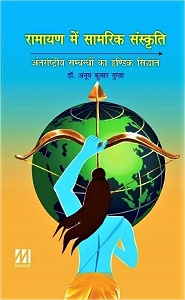Several studies have been conducted on different dimensions of strategic issues in different parts of the world. Even many studies have been carried out on various dimensions of the Hindu epic Ramayana, which is believed to have been written first by Maharshi Valmiki in Treta Yuga more than ten thousand years ago. What, however, was lacking was an in-depth research work on the strategic culture of the Ramayan. This void is now duly covered in the book Ramayan Men Samrik Sanskriti: Antarrashtriy Sambandhon Kaa Indic Siddhant by Anoop Gupta. By conducting such an important study on the strategic culture of the Ramayana, the author has been successful in creating a new milestone in this area.
To make the book presentable, the author has divided it into nine chapters. In the first chapter of the book Samrik, Sanskriti Aur Grand Ranniti Ki Avdhaarna, all such dimensions as the source of strategic culture and its importance, apart from grand strategy have been discussed in greater detail. The second chapter Samkalin Bharat ki Saamrik Sanskriti Par Vimarsh presents a detailed account of the strategic culture of contemporary India. In the third chapter Prachin Bharat Ki Samrik Sanskriti Par Vimarsh, an effort has been made to throw light on the ancient strategic culture in a proper perspective.
In the fourth chapter of the book Ramayankaalin Bhoo-SamrikParivesh, the author finds that there was a multi-polar rather than unipolarworld in the रा Ramayana period. No one state at that time had control over the entire world. However, Ravan, the King of Lanka, was struggling hard to establish a unipolar world. This posed a greater threat to the world peace order as he did not believe in the principle of co-existence‘to live and let the others live.’ He was, in fact, the epitome of conflict, injustice and cruelty, unlike Ram who stood for peace, justice and public welfare. Thus, the world during the Ramayana period was divided between Ram-led strategic culture and रावण Ravan-led strategic culture.In the rift between the two cultures, the celestial forces were in favour of Ram.
In the fifth chapter Ravan Kaa Samrik Chintan, the author presents a vivid account of Ravan’s offensive policy. In the process of expanding his empire, he tried to grab power and wealth even through unjust means. For this, he used such tactics as deceit, magic, alliance, and dissension and followed the carrot-and-stick policy. He also focussed on arms collection and strengthening his intelligence-gathering mechanism to achieve his goal. The sixth chapter of the book Ravan Kii Ranniti shows that Ravan never had any regard for human values.
In the seventh chapter of the book Ram Ka Samrik Chintan, there is a focus on the strategic thinking of Ram, which is solely based on human and spiritual values. Like Ravan, Ram, too, seems to be in favour of gaining power. But unlike Ravan, he utilises power not to torture any living body but to maintain peace and harmony in society. Ram accords the highest priority to human values, public welfare, security of the state and above all Dharma (right behaviours). He did not have any taste for war. As such, he even goes to the extent of making a treaty with his arch-enemy Ravan if he could return his wife to him. But when war is imposed upon him, he does not shrug from warring. In strategic affairs, Ram without fail makes collective decisions. Even during the war, he uses force with utmost restraint to avoid any major casualties. As per the need, he uses soft and hard power while fighting with the enemies.
In his strategic behaviour, Ram tries his best to maintain a unique balance between the external and domestic fronts of the state. On the external front, he uses his intelligence machinery to discover the weaknesses of his enemies to defeat them. At the same time, he is vigilant about the weaknesses of his side for the protection of his forces. On the other hand, on the domestic front, Ram focuses on good governance. He maintains that the primary objective of the state should be to maximise the wealth and happiness of the people. In his governance system what is popularly called Ram Rajya, no one suffers from any physical or mental disease. People do not have threats from thieves and dacoits. They live happily as there are hardly any natural calamities like droughts, floods, or earthquakes. Everybody loves each other. No woman isa widow. No one dies immaturely. No one is greedy. No one lies. All the people have prosperous lives and they follow धर्म Dharma from the core of their hearts.
In the eighth chapter of the book Ram Kii Ranniti, the strategic activities of Ram are described in greater detail. When the security of the state and rule of law is threatened, Ram uses strong power against such demons as Tatkaa, Marich, Subahu, Shurpnakha, Khar-Dushan, Bali, Ravan, Kumbhkarn, Meghnad and Lavan. His strategic thoughtis guided by Dharm, idealism, spiritualism, public welfare, justice, and the security of the state, which appear to be realistic.
A comparative study of Ram’s model of strategic culture and Ravan’s model of strategic culture is made in the last ninth chapter of the book Ramayan Men Samrik Sanskriti Ki Prasangitaa. In Ram’s model of strategic culture, power is accumulated for public welfare whereas, in Ravan’s model of strategic culture, power is accumulated for the expansion of the empire to add to the suffering of the people.
After the study of the two equally opposite strategic cultures of Ram and Ravan, it becomes clear that life becomes harmonious and peaceful only by following Ram’s model of strategic culture. Ravan’s model of strategic culture invites nothing but chaos and disorder at the individual, family, social, national and international levels. The world will benefit only by following Ram’s model of strategic culture and not Ravan’s model of strategic culture. Ram’s model of strategic culture is useful to all for all the time to come. Besides the common people, it is also useful to the heads of state or diplomats and all those who are dealing with strategic issues at the academia, think tanks and other relevant agencies.











Post new comment